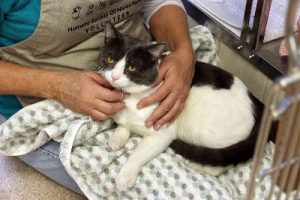As you may have recently heard in the news, a tiger in the Bronx zoo became mildly ill and tested positive for COVID-19. There have also been media reports about a small study just published suggesting that domestic cats are susceptible. Dogs may be vulnerable too, but the evidence points to this being less likely. In this study, a few cats and kittens were injected with mega doses of the virus, contracted the disease and infected other cats.
Understandably, these stories are adding to the confusion and worry about how to keep ourselves and our animals safe. But neither the zoo situation nor recent studies replicate real-world situations relating to our companion animals, and there is no cause for alarm.
This news is not surprising. COVID-19 is a new virus but is part of a family of coronavirus diseases. Many different coronaviruses affect both people and animals. In fact, one of the treatments used on cats with Feline Infectious Peritonitis (FIP), caused by a coronavirus, is being tested for possible efficacy in treating COVID-19 in humans.
We also know that COVID-19 has spread around the world, and there has been almost no evidence of pets getting sick. Of the over 1.6 million confirmed human cases, there was one story about a cat in Belgium becoming ill and a report on two dogs in China testing positive. But, there has not been one reported case to date of pets transmitting the disease to humans. Additionally, many experts believe pets, if infected, will not suffer the same severe symptoms seen in some people and will likely be “dead-end” hosts.
Of course, there has also been minimal testing, and the science is just emerging, so we want to be cautious and attentive to new information about how this global pandemic might impact the animal population.

The most important take-away is that those who test positive or have symptoms should avoid contact with their pets similar to distancing from other people, as is already recommended by the CDC. This is why it is so critical that people include their pets in their emergency preparedness plans. We should also include our pets in the social distancing we practice with those outside of our homes.
So there is no need to panic about this news. Fear can cause people to behave irrationally, as we saw in China when pets were being killed, abandoned, and starved due to the outbreak. We will rely on the research and wait to learn more over time. But, let’s also encourage the scientific community to learn more by using the vast real-life case studies available instead of adding to the millions of dogs, cats, and other animals killed in laboratories for information with limited applicability.
There are many zoonotic diseases, spread between animals and people, which can be dangerous. That’s why it is essential for both animals and public health to keep the pet population healthy and properly vaccinated. But, as scientists and health experts advise, the focus on stopping the spread of COVID-19 needs to be on human-to-human infection.
I would be remiss, however, if I failed to mention a different kind of critically pressing issue related to human and animal interaction and disease. As scientists believe that COVID-19 originated from bats and pangolins brutalized and sold at “wet markets” in China, we’ve received another stark call to action on how we treat animals across the globe.
Infectious diseases like SARS, MERS, Ebola, deadly flu outbreaks, e-Coli, and now COVID-19 are arising from the dangerous, dirty, systematically cruel, and largely unregulated ways we now treat animals used for food and force stressed wildlife to live in closer proximity to people. As such, according to the CDC, seventy-five percent of new and emerging diseases will spread from animals to people.
To make a lasting difference for our health and that of animals and mother earth, we need to end live wild animal markets, wildlife trade/trafficking, factory farming, and relentless deforestation and habitat destruction. Our interconnectedness has never been more evident. As we do to them, we do to ourselves.
Companion animals are part of our families, and wild animals are a part of our survival. Let’s follow expert advice, take care of ourselves and those we love, and work together to be better stewards of mother earth and all those who call her home.
We are, indeed, all in this together.



